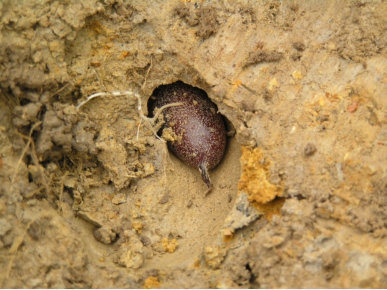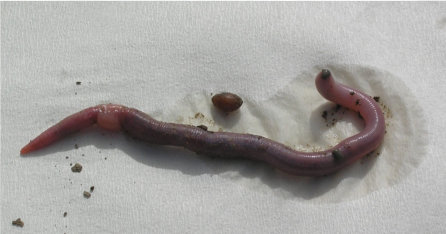
Giant Gippsland Earthworm
No-one has ever caught Giant Gippsland Earthworms (GGEs) in the act but it seems they like the lights out as it all appears to occur underground within their
burrows. Each worm has both male and female sex organs. However, two worms are required for mating as they exchange sperm with each other. How they
actually meet another worm and achieve this within the confines of their burrow is not known. Like most earthworms, they probably couple together, side by
side in reverse position, aligning the male openings so they can exchange sperm. The sperm of the partner is stored in little chambers called spermathecae.
When they are ready to produce egg cocoons, their clitellum (often called a saddle) swells in size and secrets the egg case and fluid that sustains the growing
worm. The cocoon case slides slowly forward, picking up eggs and stored sperm as it moves over the head of the earthworm and eventually hardens.
Fertilization occurs inside the egg cocoon. The breeding season occurs in spring and summer where breeding adults are recognisable by a large swelling that
occurs near their head.
Swollen clitellum that secretes cocoon


Some earthworms can lay up to 1000 egg cocoons per year with many young in each cocoon. However, the GGE produce only one large, amber-coloured egg
cocoon which can be as long as 9 cm. These are laid in special chambers that branch from their burrows, usually within 40cm of the soil surface. It is thought
that it takes about 12 months for incubation to occur and the worm emerges from the cocoon when conditions are suitable. At around 20-30 cm, the baby is
already on its way to becoming a giant.
Growing worm inside
egg cocoon
Egg cocoon in soil chamber
Egg cocoon in soil chamber
Newly hatched Giant Gippsland Earthworm.
Note the dark purple head and
absence of ditellum.
Adult introduced worm
(note swollen clitellum)
and egg cocoon.
Click any image to enlarge
Click to enlarge


Click to enlarge
Website by VP-IT
All photographs © Dr. Beverley Van Praagh, Invert-Eco unless otherwise stated. No image may be saved, copied, reproduced or distributed without prior permission from the copyright owner.
Email: info@giantearthworm.org.au
The Secret Sex Lives Of Worms


Egg cocoon

Growing worm inside
egg cocoon


Giant Gippsland Earthworm
Giant Gippsland Earthworm (GGE)
• About GGEs • Take The ‘Do I Have Worms On My Property?’ Test • The Secret Sex Lives Of Worms • What Threats Do GGEs Face?


No-one has ever caught Giant Gippsland Earthworms
(GGEs) in the act but it seems they like the lights out as it
all appears to occur underground within their burrows.
Each worm has both male and female sex organs.
However, two worms are required for mating as they
exchange sperm with each other. How they actually meet
another worm and achieve this within the confines of
their burrow is not known. Like most earthworms, they
probably couple together, side by side in reverse position,
aligning the male openings so they can exchange sperm.
The sperm of the partner is stored in little chambers
called spermathecae. When they are ready to produce
egg cocoons, their clitellum (often called a saddle) swells
in size and secrets the egg case and fluid that sustains the
growing worm. The cocoon case slides slowly forward,
picking up eggs and stored sperm as it moves over the
head of the earthworm and eventually hardens.
Fertilization occurs inside the egg cocoon. The breeding
season occurs in spring and summer where breeding
adults are recognisable by a large swelling that occurs
near their head.
Swollen clitellum that secretes cocoon


Some earthworms can lay up to 1000 egg cocoons per year
with many young in each cocoon. However, the GGE
produce only one large, amber-coloured egg cocoon which
can be as long as 9 cm. These are laid in special chambers
that branch from their burrows, usually within 40cm of the
soil surface. It is thought that it takes about 12 months for
incubation to occur and the worm emerges from the
cocoon when conditions are suitable. At around 20-30 cm,
the baby is already on its way to becoming a giant.
Growing worm inside
egg cocoon
Egg cocoon in soil chamber
Egg cocoon in soil chamber
Newly hatched Giant Gippsland Earthworm.
Note the dark purple head and
absence of ditellum.
Adult introduced worm
(note swollen clitellum)
and egg cocoon.
Click any image to enlarge
Click to enlarge


The Secret Sex Lives Of Worms
Click any image to enlarge
All photographs © Dr. Beverley Van Praagh, Invert-Eco unless otherwise stated.
No image may be saved, copied, reproduced or distributed without prior
permission from the copyright owner.
Email: info@giantearthworm.org.au
Website by VP-IT


Egg cocoon

Growing worm inside
egg cocoon


















